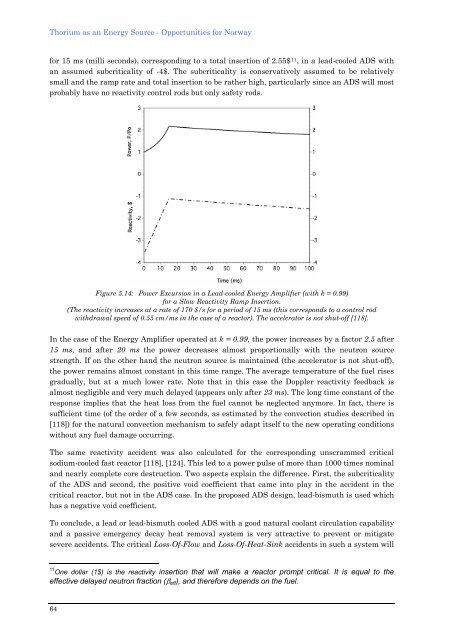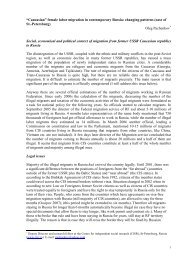THORIUM AS AN ENERGY SOURCE - Opportunities for Norway ...
THORIUM AS AN ENERGY SOURCE - Opportunities for Norway ...
THORIUM AS AN ENERGY SOURCE - Opportunities for Norway ...
You also want an ePaper? Increase the reach of your titles
YUMPU automatically turns print PDFs into web optimized ePapers that Google loves.
Thorium as an Energy Source - <strong>Opportunities</strong> <strong>for</strong> <strong>Norway</strong><br />
<strong>for</strong> 15 ms (milli seconds), corresponding to a total insertion of 2.55$ 11 , in a lead-cooled ADS with<br />
an assumed subcriticality of -4$. The subcriticality is conservatively assumed to be relatively<br />
small and the ramp rate and total insertion to be rather high, particularly since an ADS will most<br />
probably have no reactivity control rods but only safety rods.<br />
Figure 5.14: Power Excursion in a Lead-cooled Energy Amplifier (with k = 0.99)<br />
<strong>for</strong> a Slow Reactivity Ramp Insertion.<br />
(The reactivity increases at a rate of 170 $/s <strong>for</strong> a period of 15 ms (this corresponds to a control rod<br />
withdrawal speed of 0.55 cm/ms in the case of a reactor). The accelerator is not shut-off [118].<br />
In the case of the Energy Amplifier operated at k = 0.99, the power increases by a factor 2.5 after<br />
15 ms, and after 20 ms the power decreases almost proportionally with the neutron source<br />
strength. If on the other hand the neutron source is maintained (the accelerator is not shut-off),<br />
the power remains almost constant in this time range. The average temperature of the fuel rises<br />
gradually, but at a much lower rate. Note that in this case the Doppler reactivity feedback is<br />
almost negligible and very much delayed (appears only after 23 ms). The long time constant of the<br />
response implies that the heat loss from the fuel cannot be neglected anymore. In fact, there is<br />
sufficient time (of the order of a few seconds, as estimated by the convection studies described in<br />
[118]) <strong>for</strong> the natural convection mechanism to safely adapt itself to the new operating conditions<br />
without any fuel damage occurring.<br />
The same reactivity accident was also calculated <strong>for</strong> the corresponding unscrammed critical<br />
sodium-cooled fast reactor [118], [124]. This led to a power pulse of more than 1000 times nominal<br />
and nearly complete core destruction. Two aspects explain the difference. First, the subcriticality<br />
of the ADS and second, the positive void coefficient that came into play in the accident in the<br />
critical reactor, but not in the ADS case. In the proposed ADS design, lead-bismuth is used which<br />
has a negative void coefficient.<br />
To conclude, a lead or lead-bismuth cooled ADS with a good natural coolant circulation capability<br />
and a passive emergency decay heat removal system is very attractive to prevent or mitigate<br />
severe accidents. The critical Loss-Of-Flow and Loss-Of-Heat-Sink accidents in such a system will<br />
11 One dollar (1$) is the reactivity insertion that will make a reactor prompt critical. It is equal to the<br />
effective delayed neutron fraction (β ), and there<strong>for</strong>e depends on the fuel.<br />
eff<br />
64

















